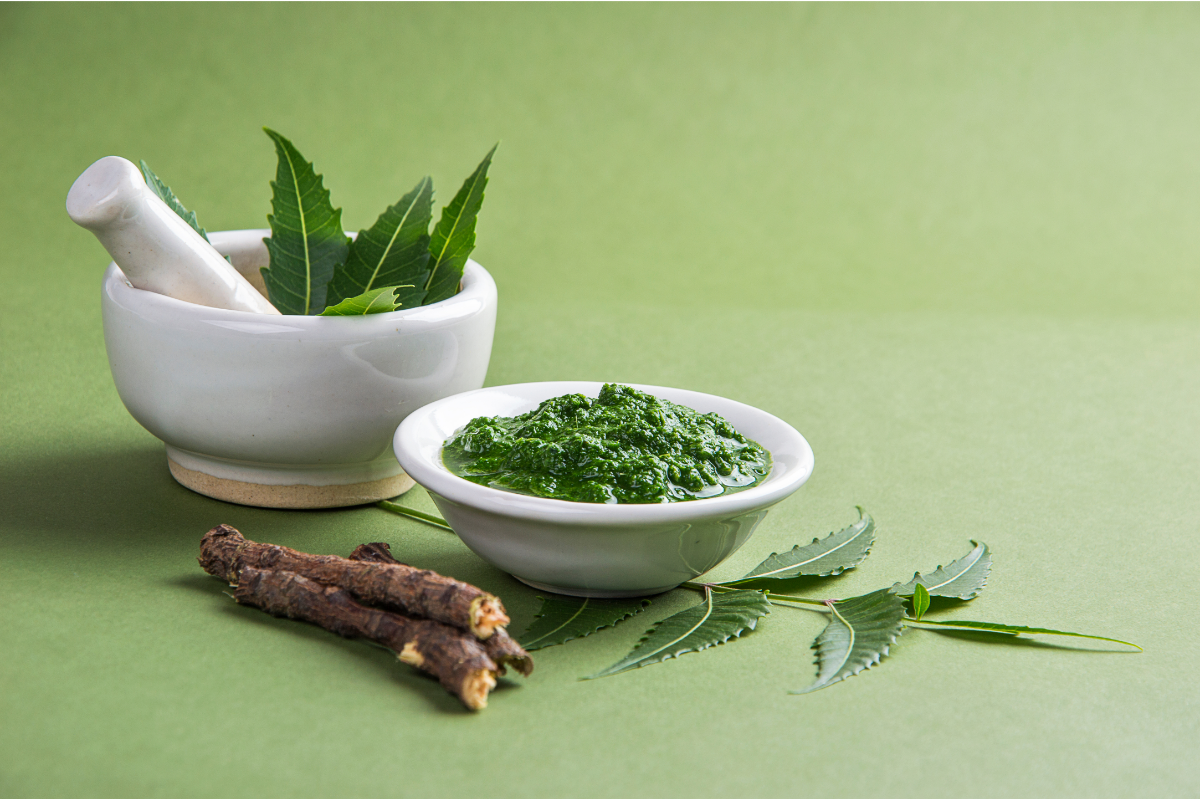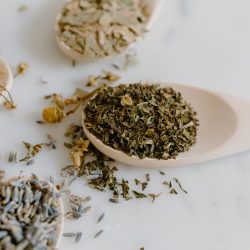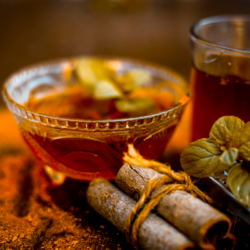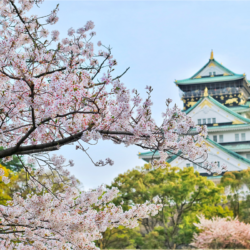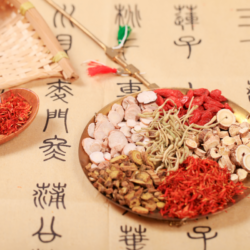Herbal medicine offers solutions for treat yourself with plants. Whether you’re looking for a better night’s sleep or a slimming boost, phytotherapy – the use of medicinal plants– is a natural way of dealing with everyday problems. It is both an alternative and a complementary solution to conventional medical treatments, which are becoming increasingly popular and whose effectiveness is increasingly recognised. This article looks at the different ways of using medicinal plants: herbal teas, plant powders and extracts, mother tinctures, etc
“Medicinal plants are used to treat “minor pathologies”. After a certain point, you need to know how to hand over to a health professional, a doctor or a pharmacist, who alone can make a diagnosis and issue a prescription for treatment with medicines”- Olivier Escuder, researcher at the Muséum national d’Histoire naturelle
Herbal teas
The tisane, defined by the French Pharmacopoeia as a mixture of plants for officinal preparations, standardises these preparations. It includes three appendices: lists of medicinal plants and plant drugs to improve the flavour and appearance of herbal teas. The mixtures consist of herbal drugs for use in herbal teas. There are strict rules: no more than 10 herbal drugs, including five that are active at 10% of the total weight, three for flavour (15% max) and two for appearance (10% max).
Active drugs must have similar or complementary medicinal properties and identical preparation methods (maceration, infusion, decoction). Drugs with different degrees of fragmentation should not be combined, and mixtures should be stored in a dry place, away from light, with storage depending on which of the drugs has the shortest shelf life.
The EMA and the HMPC, via the “Glossary on herbal teas”, are standardising the lexicon of medicinal teas. They focus on herbal medicinal products (HMP) and traditional herbal medicinal products (THMP), emphasising the importance of preparation methods. The community monographs created by the HMPC specify the dosage and method of administration.
According to the EMA, herbal teas are oral aqueous preparations (decoctions, infusions, macerations). The HMPC document harmonises the terms for preparing medicinal herbal teas, in the absence of existing guidelines. It should be consulted in conjunction with legislation on Community monographs and lists of herbal substances.
Herbal teas release various constituents of the plant into the aqueous medium. These may be polyphenolic compounds (phenolic acids, flavonoids, catechic or gallic tannins, anthocyanosides), mucilages, mineral salts, trace elements, vitamins B1, B2 and C, and phytohormones.
Infusion
An infusion is generally made with the flowers and leaves of plants, but in some cases it is also possible to infuse roots and barks. The principle is simple: you pour boiling water over the plant (about a teaspoon of plant per cup), and leave to infuse for between ten and twenty minutes. An infusion can be kept in the fridge for up to 48 hours. In principle, it is preferable not to sweeten herbal teas. As not all plants are equally pleasant to the taste, you can sweeten your herbal tea with a spoonful of honey.
Decoction
Decoctions are best suited to the underground parts of plants, such as roots and bark, which are difficult to release their active ingredients when infused. Plants such as liquorice, ginseng and dandelion are commonly decocted. This method extracts the properties of the plants by simmering them in boiling water. Use one tablespoon of herbs per cup.
Chop or grind the plants using a blender or coffee grinder. Then put them in a saucepan, cover with cold water, bring to the boil and simmer for around twenty minutes until the liquid has reduced by a third. Leave to infuse and cool for an hour before straining. Keep the decoction in the fridge for three days.
The decoction technique involves keeping the plants boiling for 15 to 30 minutes, which is effective for extracting the active components from hardy plant parts such as roots, rhizomes and bark. For woody medicinal plants, follow these steps:
- Put 1 tablespoon (5 to 8g) of plant in a stainless steel saucepan.
- Add 500 ml of water and bring to the boil.
- Simmer for 5 to 30 minutes, covered to prevent evaporation.
- Strain and consume the decoction, sweetened or not, within 24 hours, hot but kept cool.
The decoction takes 15 to 30 minutes. After boiling, filter after a short rest. An alternative is to throw the plant into the boiling water. This method, although effective for hard plants, may destroy certain components. The decoction can be used to infuse other plants.
Maceration
The maceration of medicinal plants is a simple and effective method of creating natural remedies. It involves immersing the plant drug, fresh or dried, in a liquid such as water or alcohol, at room temperature (around 25°C), for at least 30 minutes. Leaves, flowers, seeds and soft parts macerate for between 10 and 12 hours, while chopped stems, bark and soft roots macerate for between 16 and 18 hours. Hard parts macerate for 22-24 hours before filtering.
This method preserves the plants’ mineral salts and vitamins. Plants such as camomile, thyme, lavender, calendula and peppermint, with a variety of therapeutic properties, are often used. Alcoholic macerations are more concentrated and stronger, which is why it’s important to respect the dosage.
Making macerations at home contributes to natural well-being and can relieve many common ailments. However, it is advisable to consult a health professional before using them. Maceration involves soaking plants in cold water for several hours, with precise doses depending on the volume of water. It can also be done in alcohol, glycerine or other solvents.
Maceration at room temperature lasts from 30 minutes to 48 hours. For herbal teas, water is the solvent used. This gentle method is suitable for heat-labile active ingredients and allows certain undesirable constituents to be excluded. The macerate obtained is consumed the same day.
Disadvantages include a risk of bacterial contamination in the absence of boiling, longer preparation times and limited shelf life. Maceration is also used to prepare other phytogenic forms with different solvents such as wine, oil, alcohol or glycerine.
Other methods
Digestion, which is not widely practised, involves keeping a plant drug in contact with drinking water at a temperature below boiling, but above room temperature, for a period of 1 to 5 hours. It is in fact a form of hot maceration. This process is rarely used, except for certain plants such as the root of Virginia Polygala (Polygala senega L.), known for its anti-tussive, anti-inflammatory, bronchial and diuretic effects, or the rhizome of Valerian officinalis (Valeriana officinalis L.), used against nervous agitation, anxiety and sleep disorders.
Leaching is also an unusual form of herbal tea. This is a technique for extracting soluble products which involves allowing water to flow slowly, by gravity, through a powdered solid: the plant drug. The liquid then carries away the soluble active ingredients. This principle is similar to that of a coffee machine, producing a liquid called leachate.
Tinctures
Tinctures have two main advantages: they can be kept for up to three years, and the active plant ingredients they contain are rapidly absorbed by the body. The principle behind tinctures is to capture the plant’s active ingredients by macerating it, usually in alcohol. You can use ethyl alcohol sold in pharmacies, but you can also use vodka. The plants are macerated in 60° alcohol or in a mixture of alcohol and water, for several weeks (between two and five).
The resulting product is called a mother tincture. It’s best to macerate dried plants, as some fresh plants can be toxic. Place the plants in a glass jar and pour the alcohol (or alcohol-water mixture) over them. Close the jar and keep it in a cool place for a few weeks, shaking it from time to time. Then filter the mixture and pour it into a carafe before pouring the liquid into small bottles and labelling them. If the tincture is more than three years old, it should be refiltered.
Example of use: 200 grams of fresh herbs or 40 grams of dried herbs for one litre of a mixture of water and 25° alcohol. To obtain 25° alcohol from 40° vodka, add 37.5 cl of water to 60 cl of alcohol.
You can also grind the plants in a solvent, counting five volumes of liquid solvent for the equivalent of one volume by dry weight of plants. Put the mixture in a blender and leave it to macerate for several weeks, stirring daily. The mixture should then be filtered, and preferably stored in a tinted glass bottle: light can alter the active ingredients contained in the tincture. Keep the bottle away from light and heat.
Oil infusions
Medicinal oil infusions are an ancient art, combining the benefits of nature with the wisdom of traditional medicine. At the heart of this art lies the ability of oils to capture the essence and therapeutic properties of various plants and herbs. These oily preparations, obtained by infusing plant materials in carrier oils, offer a gentle, natural method of supporting health and well-being.
Throughout the ages, many cultures have developed their own infusion techniques and recipes, exploiting the richness of local plants to create remedies for a multitude of ailments. From soothing muscular aches and pains to promoting relaxation and revitalising the skin, medicinal oil infusions have become an essential part of the natural pharmacopoeia.
Cold oil infusion
The cold oil infusion technique involves filling a large glass jar with plants, then covering them with oil. Instructions: 250 grams of dried herbs or 500 grams of fresh herbs for 50 cl of pure vegetable oil (sweet almond, sunflower or grapeseed oil). Close the jar and leave to macerate for a fortnight in a sunny place. Once this period has elapsed, filter the oil by pouring it into a carafe. Then pour the liquid into dark glass bottles. It’s best to choose small bottles: once they’ve been opened, the oil spoils very quickly. Note: to obtain a higher content of active ingredients, you can repeat the same operation several times with the same oil, changing the plants each time.
Infusion with hot oil
To make creams, ointments or massage oils, you can infuse medicinal herbs in hot oil. Sunflower, sweet almond or safflower oils are recommended. Instructions for use: prepare a bain-marie by placing a glass container over a pan of simmering water. Pour the oil and herbs into the container, in a ratio of 250 grams of dried herbs or 500 grams of fresh herbs to 50 cl of pure vegetable oil (sweet almond, sunflower or grapeseed oil). Leave to ‘cook’ for two hours over a low heat, before straining into a carafe. Squeeze out the oil remaining in the filter and pour into dark glass bottles. Store in a cool place for three months.
Topical applications
Apart from oral administration, topical use is highly recommended for herbal preparations. The following products are extremely beneficial for skin care in the case of wounds, bruises and local infections.
Ointments
Ointments can be made from a variety of animal fats (lanolin, lard, shea butter or coconut butter).
Preparing ointments is simple: they consist of vegetable oil (such as sweet almond oil), beeswax and essential oils. These fats form a protective layer on the skin. To prepare, use 25 grams of beeswax for 10 cl of vegetable oil and 20 to 30 drops of essential oils. Melt the wax and oil in a bain-marie, then remove from the heat and stir with a wooden spoon until the mixture hardens. Then add the essential oils and pour into small tinted glass jars to keep for several months.
The ointment, a semi-solid topical formulation for medicinal use, is made up of lipids, waxes and resins. Water-free, it is stable and long-lasting. To make it, mix 250g of animal fat (lanolin, shea butter) with herbs, heat in a bain-marie, leave overnight, reheat and add essential oils if necessary. Filter and pour into wide-mouth containers, then store in a cool place.
Historically used in various cultures, ointment treats a variety of skin problems. It releases active ingredients in a controlled way, creating a protective barrier on the skin. For cracks, apply a thick layer; for dryness, a thin layer after heating; for other irritations, apply the same. Ointments are also used to soothe irritated baby skin, treat dermatological problems such as eczema, after shaving or on the ends of dry hair.
Creams and ointments
Preparing an ointment follows the same principle as ointment, with the addition of water. To do this, place 25 grams of beeswax and 10 cl of vegetable oil in a glass container and heat over a bain-marie. Also heat 2.5 cl of water in a bain-marie in another container. After removing the containers from the heat, slowly pour the water over the oil-wax mixture. Stir until the cream thickens and cools, then add the essential oils while continuing to stir. Pour the mixture into small tinted glass jars to keep for several months.
Ointments are semi-solid formulations for use on the skin, releasing active ingredients locally or offering a protective and emollient action. They are generally composed of a single-phase lipid excipient, sometimes enriched with solids or liquids.
Herbaceous ointments, rich in active plant ingredients, are absorbed effectively by the skin. Burdock, chamomile and plantain are suitable for sensitive skin, while ginger or cayenne in small quantities are useful for a thermogenic action on the joints.
The choice of base oil depends on the use: castor oil for an intensive effect, olive oil for a versatile base, and almond or argan oil for facials. However, coconut oil may be less suitable due to its solidity at room temperature and its drying effect on certain skin types.
To prepare the ointment:
- Heat 10 tablespoons of medicinal oil and 2 ½ tablespoons of beeswax in a double boiler.
- Stir until the wax is incorporated and add a few drops of essential oils when the preparation is warm but liquid.
- Place in a jar and leave to set.
Plant extract compresses
To make a compress, use an infusion or decoction of plants, soak a clean cloth in it and place it over the painful area. You can tie it up with a towel or bandage.
Herbal compresses, a traditional method, effectively treat a variety of ailments and health problems. Using fresh or dried plants, they relieve pain, reduce inflammation, stimulate healing and improve general health.
A medicinal compress involves applying a plant paste, decoction or hot infusion directly to the skin. The active principles of the plants thus penetrate the skin, providing a local therapeutic effect.
There are several methods for preparing compresses. A decoction is made by boiling the plants in water, then applying the liquid to the affected area. Infusion is achieved by pouring boiling water over the plants, followed by application to the skin. Another option is to crush fresh plants into a paste, then apply it to the affected area.
Medicinal compresses reduce inflammation, soothe pain, promote tissue healing, prevent infection and relieve stress thanks to the aromas of the plants. They are useful for :
- Relieving muscle and joint injuries
- Treating dermatological problems
- Alleviating menstrual pain
- Reduce cold symptoms
- Treating minor injuries.
It is important to consult a health professional before using them, especially if you have a medical condition or are taking medication. The compresses are particularly suitable for skin problems, sprains, fractures and musculoarticular pain. They are for single use only.
To use them, soak a clean compress or cloth in an infusion or decoction of the plant, apply it to the skin, secure with a bandage and leave in place for around twenty minutes, repeating after a few hours.
Poultices
The principle is the same as for compresses, with the difference that here it is the herbs that are used directly, rather than an infusion. The plants are coarsely chopped and then heated in a pan, covered with a little water. Leave to simmer for two or three minutes. Squeeze the herbs, then place them on the area to be treated. Cover with a bandage or piece of gauze. A poultice can be kept on for three or four hours, changing the herbs every hour if necessary.
Based on medicinal plants
A poultice is a preparation of fresh or cooked medicinal plants applied directly to the skin. To prepare it, chop the plants and purée them, adjusting the texture with water if necessary. Spread this preparation on gauze and place over the area to be treated, smearing with oil to prevent sticking. Secure the poultice with a bandage and replace it after several hours to ensure even distribution of the active ingredients.
For fresh plants, chop or crush them to extract the juice, or steam them. With dried plants, form a paste by mixing with hot water. To keep the heat in, cover the poultice with a hot water bottle. If irritation occurs, remove the poultice and apply marigold ointment.
Poultices apply the benefits of plants directly to the skin. They are used to extract foreign substances from wounds or to soothe inflammation. For example, a poultice of fresh ginger relieves painful joints.
Poultices are used for healing, relieving muscle pain, reducing inflammation or treating skin conditions. Common plants for poultices include comfrey for bones and sprains, green clay for inflammation, cabbage for joint pain, mustard for muscle pain, flax for wounds, chamomile for skin irritations, ginger for pain, plantain for stings and cuts, fenugreek for inflammation and garlic for its antiseptic and anti-inflammatory properties.
Algotherapy
Algotherapy, including seaweed treatments, is an essential component of thalassotherapy, offering a wealth of health benefits. Seaweed is a natural filter, absorbing elements from seawater and containing minerals, vitamins, amino acids and other beneficial components. They have antibacterial and antiviral properties and are used to treat muscular pains, skin problems and many other ailments.
Seaweed, such as kelp and fucus vesiculosus, offer specific properties such as detoxification and stimulation of sweating. Application methods vary from wraps and local applications to baths and other techniques.
Algotherapy, using seaweed, is rich in trace elements, amino acids and vitamins, and is recognised for its antiseptic, anti-inflammatory and detoxifying properties. Treatments take the form of seaweed wraps or heated seaweed baths, providing relaxation, detoxification and remineralisation for the body.
This 100% natural practice is attracting more and more people for its benefits. Some seaweed can even have an appetite-suppressant effect, while providing essential nutrients.
Algotherapy relieves muscular and joint problems thanks to its detoxifying and remineralising effect. Each type of seaweed retains marine elements in a different way, such as fucus, which induces sweating to eliminate toxins and has slimming properties thanks to its high iodine content.
In wraps, warm seaweed applied to the body stimulates blood circulation and helps to eliminate toxins. These treatments are often performed in beauty salons and thalassotherapy centres, where you can relax and feel good.
Clay therapy
Clay therapy, combined with herbal poultices, takes advantage of the therapeutic properties of clay. This ancient practice uses clay to eliminate toxins, reduce inflammation, relieve pain and promote well-being. Clay, rich in aluminium, magnesium and calcium silicates, has antiseptic, anti-inflammatory, analgesic and healing properties. It is effective against muscular pain, skin infections, acne, burns, bruises, insect bites, headaches, menstrual pain and digestive disorders.
- Different types of clay are used in clay therapy, such as kaolin, smectites and illite, each with its own specific uses. They are applied in the form of poultices, masks, baths or drinks. By acting on the skin, they stimulate blood and lymph circulation, speeding healing and reducing inflammation.
- The clay, which comes from the erosion of volcanic rock, must be pure and natural. Kaolin, white and balanced in aluminium and silica, is used in cosmetics. Smectites, like montmorillonite, are good for the digestive system. Illite, rich in calcium and iron, absorbs impurities and heals bruises.
- Clays come in a range of colours, each offering unique properties. Green clay is remineralising, white clay is soothing, while red and yellow clays are cleansing. Blue and caramel clays detoxify, while pink, a mixture of red and white, is gentle on skin and hair. Moroccan rhassoul is ideal for oily skin.
- The benefits of green clay include treating wounds, rheumatism and gastrointestinal disorders. White clay combats perspiration and improves oral hygiene. Red clay, rich in iron, is useful against anaemia.
Toxic plants
Let’s turn now to a subject that is crucial to health and safety: toxic plants, those natural elements which, despite their often harmless appearance, can present serious dangers to humans and animals.
Cases of poisoning
Accidents involving plants are a major concern, given that almost 10% of flora in France could be fatal. Plants use active metabolites as a defence, and as Paracelsus said in the 15th century, “the dose makes the poison”. However, in France, epidemiological information on this subject remains limited. There are around 100,000 calls a year to poison control centres, i.e. more than 250 calls a day, of which 4-5% concern plants.
In 2017, a photo-based plant recognition network called ” Phytoliste ” was set up. This enables botanists to assist poison centres and emergency services. In 2017 and 2018, 1,265 requests were processed, with increases during the summer and autumn. Responses, based on photo analysis, are generally provided between 2 and 15 minutes.
Children aged 0 to 4 are particularly affected, due to their reduced body mass. For farm animals, the plants involved are diverse, often linked to contaminated fodder. In the case of pets, such as cats, the data are less abundant.
In terms of plant poisoning, 7% is potentially fatal, 39% is asymptomatic, 23% causes serious symptoms and 31% causes minor digestive problems. Fatal cases are rare, generally occurring after the ingestion of small quantities.
According to the 2017-2018 Phytolist, 59% of reported cases had symptoms, mainly digestive. Accidental ingestions often result from confusion with food plants. They may also be deliberate, as in cases of suicide or the use of psychotropic plants. Errors related to phytotherapy, due to a lack of botanical knowledge or ignorance of the dangers, as well as falsification or misidentification of medicinal species, are also common.
The most common toxic plants
Common toxic plants include :
- Aconite: Causes nausea and dizziness. A dose of this root is toxic from 2 grams in an adult. It can be fatal.
- Arnica: Dangerous if swallowed, causing nausea, dizziness and even death.
- Belladonna: Poisonous plant causing dilated pupils and cardiac arrest. The toxic dose is 2 to 3 berries for a child and 10 to 15 for an adult.
- Comfrey: Toxic to the liver. An herbal tea can cause a drop in heart rate to 30 bpm and death.
- Datura: Causes vomiting, hallucinations and cardiac arrest. Most intoxications are unintentional, due to contamination of foodstuffs.
- Yellow Foxglove: Poisonous, slows down the movements of the heart. Poisonings are often suicide attempts.
- Purple Foxglove: Causes nausea, vomiting, diarrhoea and serious heart problems.
- Ephedra: Can cause palpitations, nervousness and insomnia.
- Euphorbia: Toxic.
- Germander: Causes liver problems.
- Mistletoe: Its berries are toxic. Berries can cause vomiting and diarrhoea.
- Oleander: Can cause vomiting, loss of pulse and death. Poisoning often involves confusion with bay laurel or eucalyptus.
- Lobelia: Causes nausea and vomiting.
- Spearmint: Dangerous in essential oil or tincture, prohibited for internal use.
- Lily of the valley: Risk of cardiac and respiratory arrest. Lily of the valley is often confused with wild garlic. It is thought that only the roots are lethal.
- Soapwort: May cause muscular paralysis.
It is crucial to be familiar with these plants and their effects to avoid poisoning, especially when they resemble non-toxic plants or are used in phytotherapy.
Conclusion
To sum up, phytotherapy is the use of plants in various forms: herbal teas, capsules or tinctures for preventive and curative treatment. Over 2,500 years ago, Hippocrates, the father of medicine, was already extolling the curative properties of herbs. Today, phytotherapy is an integral part of many traditional medicines, such as Chinese medicine, which often uses a variety of plants to concoct ‘potions’.
The properties, indications and methods of use listed in this article in no way constitute medical advice. They have been taken from books and websites specialising in aromatherapy. This information is provided for information purposes only and we accept no liability for it. For any therapeutic use of essential oils, consult your doctor, pharmacist or aromatherapy professional.
Sources
- https://ansm.sante.fr/uploads/2020/10/22/tisanes.pdf
- https://ansm.sante.fr/uploads/2020/10/23/melange-pour-tisanes-pour-preparations-officinales.pdf
- https://www.doctissimo.fr/html/dossiers/phytotherapie/articles/16337-infusion-plante-medicinale.htm
- https://www.ema.europa.eu/en/documents/regulatory-procedural-guideline/glossary-herbal-teas_en.pdf
- https://www.passeportsante.net/fr/Actualites/Dossiers/DossierComplexe.aspx?doc=teinture-mere
- https://ansm.sante.fr/uploads/2020/10/23/sirop-simple.pdf
- https://fr.wikipedia.org/wiki/Sirop
- https://www.altheaprovence.com/confection-dun-sirop/
- https://www.agripedia.nc/conseils-techniques/sante-au-travail/les-preparations-de-plantes-medicinales
- https://jardinaturel.com/le-cataplasme-de-plantes-medicinales/jardinage-naturel/
- https://www.rustica.fr/tisanes/bien-etre-naturel-preparer-infusions-decoctions-cataplasmes,5204.html#:~:text=The%20cataplasm%20is%20a%20pr%C3%A9paration,covering%20the%20whole%20pain%20area.
- https://www.centre-europeen-formation.fr/blog/bien-etre/argilotherapie/
- https://www.vidal.fr/parapharmacie/utilisation/bon-usage-phytotherapie-plantes/plantes-preparation.html
- https://jardinaturel.com/les-compresses-de-plantes-medicinales/jardinage-naturel/
- https://fr.wikipedia.org/wiki/Pommade

